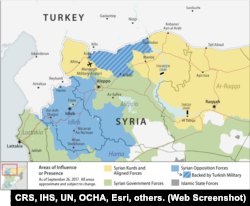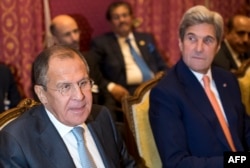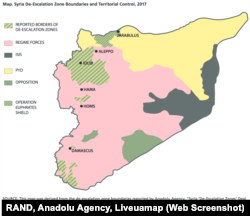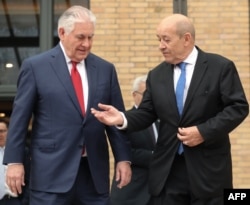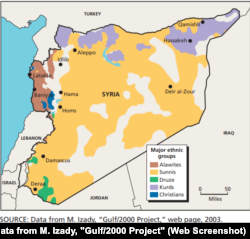Russian Foreign Minister Sergey Lavrov made the claims in an interview with Euroenews, reiterating the Kremlin’s long-standing charge that U.S. and pro-U.S. coalition forces are operating illegally in Syria, “without any invitation from Damascus, or without any mandate of the UN Security Council.”
While there is no known publicly available official U.S. document indicating that Washington plans to partition Syria, geopolitical developments and official U.S. government statements suggest Washington has considered and even pursued such a scenario. However, none of the known documentation supports Lavrov’s sweeping claim the U.S. plans to “settle forever in Syria.”
As the leader of a multi-national coalition, the U.S. has for years supported the Syrian Democratic Forces (SDF) and its military wing, the People’s Protection Units (YPG), which comprises both Kurdish and Sunni Arab fighters, in the fight against IS and government forces of President Bashar al-Assad.
But this support does not sit well with either Moscow, which backs Assad, or Ankara, which is engaged in a military offensive against the Syrian Kurds to ensure a Kurdish state does not emerge in northwest Syria or on Turkish territory. Turkey considers the YPG to be the Syrian wing of the outlawed PKK, which has been waging a decades-long insurgency against Turkey. While Washington has designated the PKK as a terrorist group, it has not similarly blacklisted the YPG.
With the Islamic State (IS) network in Syria nearly decimated and Assad’s forces making territorial gains against the U.S.-backed rebels, critics have increasingly questioned the U.S. plans and presence in Syria, where Russia’s military involvement has made the U.S. goal of removing Assad unachievable.
The United States, according to Lavrov, now seeks to shape a transition of power in Syria.
“The U.S. are trying to form ... alternative bodies of authority on vast ... parts of the Syrian territory,” contradicting its “own obligations ... to the territorial integrity and sovereignty of Syria,” Lavrov said during a UN conference on January 16, adding that this goes against U.S. promises.
Concerns that the U.S. plans to partition Syria date back several years.
In 2012, a declassified U.S. Defense Intelligence Agency report published by Judicial Watch discussed “the possibility of establishing a declared or undeclared Salafist principality in eastern Syria (Hasaka and Der Zor)” if the situation in the country “unravels.” However, the report did not include a concrete plan to move forward with the idea.
At the time, the U.S. had no military presence in Syria. That came three years later. It is noteworthy, also, that the Kurdish Democratic Union Party (PYD) began setting up government councils in 2012, according to its political ideology of decentralized governance known as “democratic confederalism,” long before the U.S. military joined the Syrian conflict.
The 2012 DIA report did not contemplate a U.S. presence in Syria.
In 2015-2017, former Assistant Secretary of State James Dobbins, former White House Coordinator for the Middle East, North Africa, and the Gulf Region Philip Gordon, and former North Africa head for the U.S. State Department’s Bureau of Conflict and Stabilization Operations Jeffrey Martini, penned a four-part study proposing Syria’s de-centralization.
“It would likely involve granting extensive autonomy, including control over local security, to local authorities,” the study noted, explaining that Syria could be split into four zones – one controlled by Damascus; one by the Kurds; one by the Sunni opposition; and one by IS.
Dobbins’ report suggested the best outcome at the time would have been an agreed-upon cease fire “accompanied by internationally agreed arrangements for its enforcement” – not a suggestion of a U.S. military presence.
In 2015, The Hill reported that Israeli security experts had leaked information indicating that Washington and Moscow were in talks aimed at partitioning Syria.
Notably, the Obama administration considered partitioning Syria if a planned cease-fire failed. “It may be too late to keep it as a whole Syria if we wait much longer,” John Kerry, then U.S. secretary of state, told the U.S. Senate Committee on Foreign Relations in February 2016.
“Assad himself is going to have to make some real decisions about the formation of a transitional government process that is real…there are certainly plan B options being considered,” he added. But Kerry was silent about any increased military involvement and he did not advocate partition.
Yet, Andrew Tabler, a Syria expert at the Washington Institute for Near East Policy, wrote at the time that the United States was already pursuing plan B: “Changing the demography of any country is the necessary, if not quite sufficient, precondition for partition…the White House’s Plan B for Syria is already its Plan A. The only question is whether this is by accident or by design.”
Chris Harmer, an analyst with the Institute for the Study of War, said the partitioning of Syria was unintended outcome of the “reactive” policymaking of the United States.
With anti-IS operations winding down in Syria, some Western experts and advocates believe the U.S. now appears to be looking for ways to anchor its presence in Syria in pursuit of long-standing objectives through new means.
In January 2017, U.S. Secretary of State Rex Tillerson announced that the U.S. would create a 30,000-strong rebel force in northeastern Syria to secure areas under SDF control. “This will enable the Syrian people to establish effective local, representative governance and reclaim their land,” the coalition said in a supporting statement. Ankara, Damascus, and Moscow criticized the initiative, prompting Washington to backtrack on the idea but continue supporting the SDF.
Officially, Washington provides such support to prevent IS and al-Qaeda from re-emerging, to resolve the Syrian conflict through a UN-led political process without Assad in power, and to roll back Iran’s influence. Tillerson said in January that stabilization initiatives are essential to these tasks but that he recognized “some Americans are skeptical of continued involvement in Syria.”
Underscoring the need to maintain Syria’s territorial integrity, Tillerson emphasized that “interim local political arrangements” supporting “broader political transition must emerge with international support.”
In their fourth RAND policy study, published late last year, Dobbins, Gordon and Martini emphasized the importance of stabilization assistance and representative local councils to administer it.
The authors also suggested several areas with local councils already receiving “modest Western support” as possible locations for reconstruction if Damascus “resisted decentralization.”
The Congressional Research Service reports that Trump administration has requested $191.5 million in FY2018 for assistance and $500 million to train and equip anti-IS forces in Syria.







